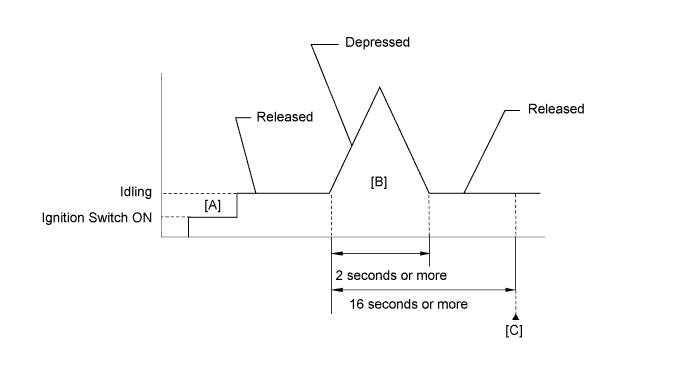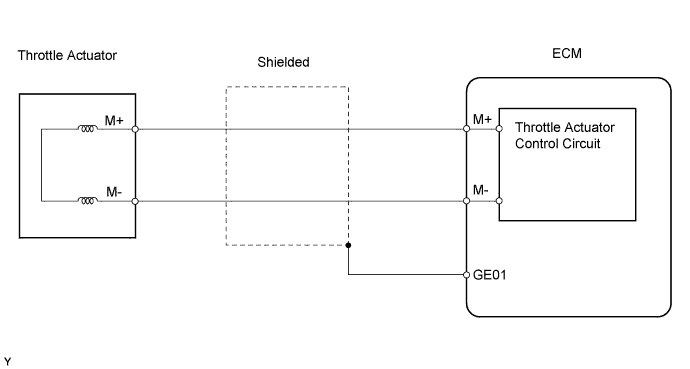Dtc P2102 Throttle Actuator Control Motor Circuit Low
DESCRIPTION
MONITOR DESCRIPTION
MONITOR STRATEGY
TYPICAL ENABLING CONDITIONS
TYPICAL MALFUNCTION THRESHOLDS
FAIL-SAFE
CONFIRMATION DRIVING PATTERN
WIRING DIAGRAM
INSPECTION PROCEDURE
INSPECT THROTTLE WITH MOTOR BODY ASSEMBLY (RESISTANCE OF THROTTLE ACTUATOR)
CHECK HARNESS AND CONNECTOR (THROTTLE WITH MOTOR BODY ASSEMBLY - ECM)
INSPECT THROTTLE WITH MOTOR BODY ASSEMBLY
INSPECT THROTTLE WITH MOTOR BODY ASSEMBLY (THROTTLE VALVE)
DTC P2102 Throttle Actuator Control Motor Circuit Low |
DTC P2103 Throttle Actuator Control Motor Circuit High |
DESCRIPTION
The throttle actuator is operated by the ECM and opens and closes the throttle valve using gears.The opening angle of the throttle valve is detected by the Throttle Position (TP) sensor, which is mounted on the throttle with motor body assembly. The TP sensor provides feedback to the ECM. This feedback allows the ECM to appropriately control the throttle actuator and monitor the throttle opening angle as the ECM responds to driver inputs. - HINT:
- This ETCS (Electronic Throttle Control System) does not use a throttle cable.
DTC No.
| DTC Detection Condition
| Trouble Area
|
P2102
| Conditions (a) and (b) continue for 2.0 seconds:
(1 trip detection logic)
(a) Throttle actuator duty ratio 80 % or more
(b) Throttle actuator current less than 0.5 A
| - Open in throttle actuator circuit
- Throttle actuator
- ECM
|
P2103
| Either of following conditions met :
(1 trip detection logic)
- Hybrid IC diagnosis signal fail
- Hybrid IC current limiter port fail
| - Short in throttle actuator circuit
- Throttle actuator
- Throttle valve
- Throttle body
- ECM
|
MONITOR DESCRIPTION
The ECM monitors the electrical current through the electronic actuator, and detects malfunctions and open circuits in the throttle actuator based on this value. If the current is outside the standard range, the ECM determines that there is a malfunction in the throttle actuator. In addition, if the throttle valve does not function properly (for example, stuck on), the ECM determines that there is a malfunction. The ECM then illuminates the MIL and stores a DTC. Example:When the electrical current is less than 0.5 A and the throttle actuator duty ratio exceeds 80 %, the ECM interprets this as the current being outside the standard range, and illuminates the MIL and stores a DTC.If the malfunction is not repaired successfully, a DTC is stored when the engine is quickly revved to a high rpm several times after the engine has idled for 5 seconds after engine start.
MONITOR STRATEGY
Related DTCs
| P2102: Throttle actuator current (low current)
P2103: Throttle actuator current (high current)
|
Required Sensors/Components (Main)
| Throttle with motor body assembly
|
Required Sensors/Components (Related)
| None
|
Frequency of Operation
| Continuous
|
Duration
| 2 seconds: P2102
0.6 seconds: P2103
|
MIL Operation
| Immediate
|
Sequence of Operation
| None
|
TYPICAL ENABLING CONDITIONS
Monitor runs whenever following DTCs not present
| None
|
P2102:Throttle actuator
| ON
|
Duty-cycle ratio to open throttle actuator
| 80 % or more
|
Throttle actuator power supply
| 8 V or more
|
P2103:Throttle actuator
| ON
|
Throttle actuator power supply
| 8 V or more
|
Battery voltage
| 8 V or more
|
Starter
| OFF
|
TYPICAL MALFUNCTION THRESHOLDS
P2102:Throttle actuator current
| Less than 0.5 A
|
P2103:Either of following conditions is met:
| A or B
|
A. Hybrid IC diagnosis signal
| Fail
|
B. Hybrid IC current limiter port
| Fail
|
FAIL-SAFE
When either of these DTCs, or other DTCs relating to ETCS (Electronic Throttle Control System) malfunctions, are stored, the ECM enters fail-safe mode. During fail-safe mode, the ECM cuts off the current to the throttle actuator, and the throttle valve is returned to a 6° throttle angle by the return spring. The ECM then adjusts the engine output by controlling the fuel injection (intermittent fuel cut) and ignition timing, in accordance with the accelerator pedal opening angle, to allow the vehicle to continue at a minimal speed. If the accelerator pedal is depressed firmly and gently, the vehicle can be driven slowly.Fail-safe mode continues until a pass condition is detected, and the ignition switch is then turned to OFF.
CONFIRMATION DRIVING PATTERN

- Connect the Techstream to the DLC3.
- Turn the ignition switch to ON and turn the Techstream on.
- Clear DTCs (even if no DTCs are stored, perform the clear DTC operation).
- Turn the ignition switch off and wait for at least 30 seconds.
- Turn the ignition switch to ON and turn the Techstream on [A].
- Start the engine.
- With the vehicle stationary, fully depress the accelerator pedal and quickly release it [B].
- Check that 16 seconds or more have elapsed from the instant when the accelerator pedal is first depressed.
- Enter the following menus: Powertrain / Engine and ECT / Trouble Codes [C].
- Read pending DTCs.
- HINT:
- If a pending DTC is output, the system is malfunctioning.
- If a pending DTC is not output, perform the following procedure.
- Enter the following menus: Powertrain / Engine and ECT / Utility / All Readiness.
- Input the DTC: P2102 or P2103.
- Check the DTC judgment result.
Techstream Display
| Description
|
NORMAL
| - DTC judgment completed
- System normal
|
ABNORMAL
| - DTC judgment completed
- System abnormal
|
INCOMPLETE
| - DTC judgment not completed
- Perform driving pattern after confirming DTC enabling conditions
|
N/A
| - Unable to perform DTC judgment
- Number of DTCs which do not fulfill DTC preconditions has reached ECU memory limit
|
- HINT:
- If the judgment result shows NORMAL, the system is normal.
- If the judgment result shows ABNORMAL, the system has a malfunction.
- If the judgment result shows INCOMPLETE or N/A, perform steps [B] through [C] again.
- If no pending DTC is output, perform a universal trip and check for permanent DTCs (YARIS_NCP93 RM000000PDK0QGX.html).
- HINT:
- If a permanent DTC is output, the system is malfunctioning.
- If no permanent DTC is output, the system is normal.
WIRING DIAGRAM
INSPECTION PROCEDURE
- HINT:
- Read freeze frame data using the Techstream. The ECM records vehicle and driving condition information as freeze frame data the moment a DTC is stored. When troubleshooting, freeze frame data can help determine if the vehicle was moving or stationary, if the engine was warmed up or not, if the air fuel ratio was lean or rich, and other data from the time the malfunction occurred.
- The throttle actuator current (Throttle Motor Current) and the throttle actuator duty ratio (Throttle Motor Open Duty / Throttle Motor Close Duty) can be read using the Techstream. However the ECM shuts off the throttle actuator current when the ETCS malfunctions.
| 1.INSPECT THROTTLE WITH MOTOR BODY ASSEMBLY (RESISTANCE OF THROTTLE ACTUATOR) |
Disconnect the C17 throttle with motor body assembly connector.
Measure the resistance of the throttle actuator.
- Standard resistance:
Tester Connections
| Specified Conditions
|
M+ (2) - M- (1)
| 0.3 to 100 Ω at 20°C (68°F)
|
Reconnect the throttle with motor body assembly connector.
| 2.CHECK HARNESS AND CONNECTOR (THROTTLE WITH MOTOR BODY ASSEMBLY - ECM) |
Disconnect the C17 throttle with motor body assembly connector.
Disconnect the C20 ECM connector.
Check the resistance.
- Standard resistance (Check for open):
Tester Connections
| Specified Conditions
|
M+ (C17-2) - M+ (C20-42)
| Below 1 Ω
|
M- (C17-1) - M- (C20-41)
|
- Standard resistance (Check for short):
Tester Connections
| Specified Conditions
|
M+ (C17-2) or M+ (C20-42) - Body ground
| 10 kΩ or higher
|
M- (C17-1) or M- (C20-41) - Body ground
|
Reconnect the throttle with motor body assembly connector.
Reconnect the ECM connector.
| | REPAIR OR REPLACE HARNESS OR CONNECTOR |
|
|
| 3.INSPECT THROTTLE WITH MOTOR BODY ASSEMBLY |
Check for foreign objects between the throttle valve and the housing.
- OK:
- No foreign objects between throttle valve and housing.
| | REMOVE FOREIGN OBJECT AND CLEAN THROTTLE WITH MOTOR BODY ASSEMBLY |
|
|
| 4.INSPECT THROTTLE WITH MOTOR BODY ASSEMBLY (THROTTLE VALVE) |
Check if the throttle valve opens and closes smoothly.
- OK:
- Throttle valve opens and closes smoothly.



